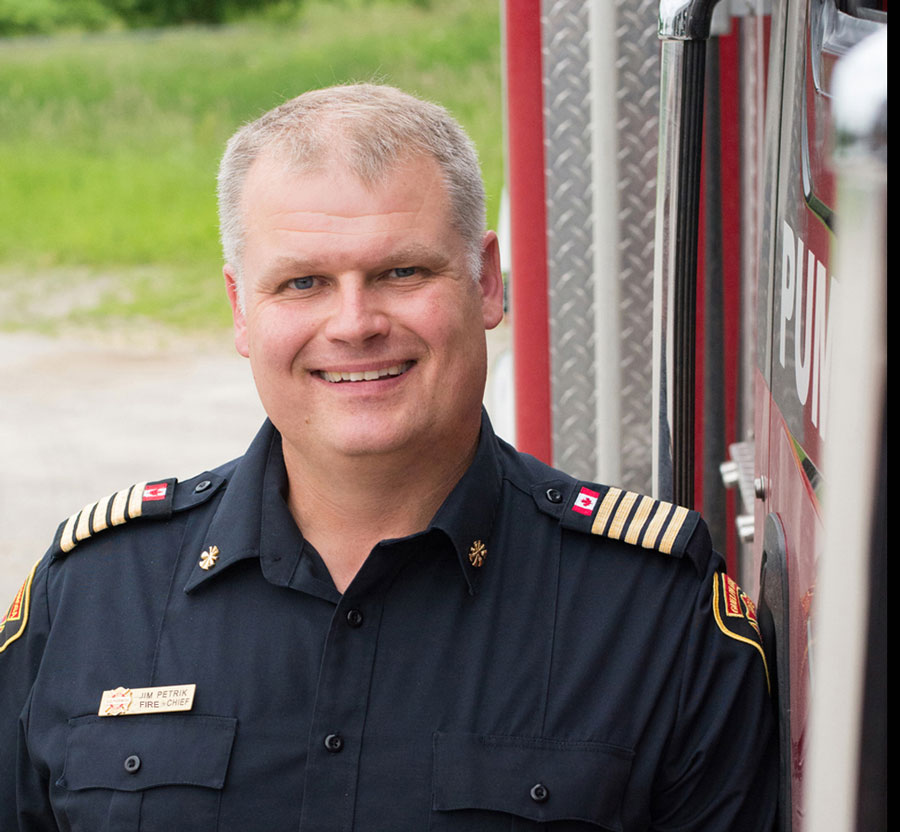ROCKWOOD – Firefighters are at such high risk of cancer that the World Heath Organization classifies firefighting as a carcinogenic.
About 94 per cent of line-of-duty deaths among professional Canadian firefighters are caused by occupational cancers, according to the International Association of Firefighters.
Guelph/Eramosa Fire Chief Jim Petrik told the Advertiser volunteer firefighters have about the same cancer risk as professionals.
Petrik is an expert in both cancer research and firefighting: he’s a professor and cancer researcher at the University of Guelph and has been fighting fires for 25 years.
He became a firefighter because he “always had a passion for helping people,” Petrik said.
Now he’s working to help fellow firefighters by spreading awareness about cancer-risks and working to improve cancer prevention protocols.
‘Absolutely devastating’
Petrik has witnessed the impacts of cancer on firefighting communities, attending a number of funerals for firefighters who died of cancer.
“It’s tragic. It’s absolutely devastating, mostly importantly for the families,” he said.
Petrik described how his fellow firefighters “truly feel as we are an extended family … we have special connections with each other.
“When we lose one of our members to cancer it’s devastating to the fire family as well. It’s a really hard thing to deal with … Tragic on many levels.”
Toxic chemicals
Firefighters developing cancer is becoming an increasingly common problem, Petrik said, because “the material that homes are made out of today [is] very different to what they were before. Houses are burning hotter and faster.”
These modern structural fires release “thousands and thousands of chemicals,” Petrik explained, and firefighters are repeatedly exposed to “really toxic environments” while fighting the fires.
To reduce exposure to hazardous compounds, firefighters wear protective equipment including bunker gear and a breathing apparatus – equipment experts once thought provided adequate protection.
But medical professionals noticed that firefighters were developing and dying of cancers at a much higher rate than the general population.
“So then we tried to figure out where is this increase coming from,” Petrik said.
They discovered much of the exposure is taking place after the firefighters leave the burning structures, he explained.
“We used to immediately take off our breathing apparatus” and rest and rehydrate before reentering structural fires, Petrik said.
And once fires were extinguished, the firefighters would jump in the truck and drive back to the fire hall – still wearing their bunker gear, with no breathing apparatuses.
Now, it’s understood bunker gear absorbs the toxic chemicals and immediately starts off-gassing those chemicals.
A firefighter wearing contaminated bunker gear, with no breathing apparatus is “constantly breathing those chemicals in and being exposed on a very high level,” Petrik said.
“And we also now know the chemicals are absorbed by our skin,” he added.
Protective protocols
Firefighting departments such as Guelph/Eramosa’s are changing safety protocols to decrease risk.
“When a firefighter comes out of that environment, comes out of the fire, before they take off the breathing apparatus, we immediately decontaminate them” by spraying them down and scrubbing them with soap and water, Petrik explained.
The firefighters then remove their bunker gear and store it in an external compartment in the truck, so they can “ride back to the hall in a much less contaminated environment,” he said.
Now that experts have a better understanding of firefighters’ increased cancer-risk they are “working to try to develop really robust screening and monitoring programs,” Petrik said, in order to identify more cases at an earlier stage, when cancers are more likely to respond successfully to treatment.
Increasing awareness
And organizations such as the International Association of Fire Fighters and the Firefighter Cancer Support Network are working to increase awareness and education regarding cancer in firefighters.
“A surprisingly high number of firefighters were not aware of this risk” before joining, Petrik said, adding that a significant number of family physicians remain unaware.
Petrik is hopeful increased awareness about firefighters’ risk of cancer could eventually lead to firefighting being officially recognized as a high-risk occupation.
“Then the provincial health care funding plans will fund more aggressive and earlier screening, which I think is critical,” Petrik said.
Last year, the Ontario government expanded cancer coverage for firefighters to make it “faster and easier for these heroes and their families to access the compensation and supports they deserve for thyroid and pancreatic cancers from the Workplace and Safety Insurance Board,” states a provincial news release.
But this coverage should be expanded further to include widespread screening and diagnosis tests, which can be expensive, Petrik said.
Between 25 and 30 Ontario firefighters die of cancer each year on average, according to the release.
Volunteers
Last year’s provincial changes apply to full-time, part-time, and volunteer firefighters.
According to the release, almost two thirds of the 30,000 firefighters in Ontario are volunteers, but Petrik said volunteers make up closer to 80% of the province’s firefighters.
“An incredibly important part of community safety is having robust community volunteer fire departments,” Petrik said.
“We owe it to these people that sign up to do whatever we can to keep them healthy.
“Province-wide there’s a general decline in the number of people signing up to be volunteer firefighters,” he said, and he attributes this at least in part to an increased awareness about the cancer risks.
“We are asking people to do dangerous things and take risks to protect our community. Now, we have to protect them,” he said.
“The most important thing is to keep them safe – not have this as an impediment for people signing up to help their community by being a volunteer firefighter.”




